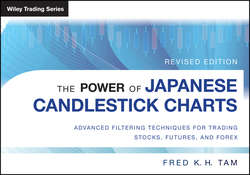Читать книгу The Power of Japanese Candlestick Charts - Fred K. H. Tam - Страница 6
На сайте Литреса книга снята с продажи.
ACKNOWLEDGMENTS
ОглавлениеAbook on Japanese candlesticks is not easy to write, mainly because of the lack of literature on the subject until 1991 when an American analyst by the name of Steve Nison revealed this ancient technique to the Western world through his classic book, Japanese Candlestick Charting Techniques: A Contemporary Guide to the Ancient Investment Techniques of the Far East.
This book was my first contact with candlesticks. Nison's second, Beyond Candles, is another masterpiece. After putting his research into practice, I am convinced of the candlesticks' usefulness in forecasting market U-turns as well as trend continuations and am now a faithful disciple of this age-old technique. Nison has my utmost respect for introducing candlesticks to the Western world and to me. He is, to me, the “granddaddy” of candlesticks.
I would also like to thank Gary S. Wagner and Brad L. Matheny for furthering my knowledge on candles. We met when I attended a U.S. International Trading and Markets Conference called “Futures West '94” in Los Angeles. Wagner and Matheny's book, Trading Applications of Japanese Candlestick Charting, taught me, besides additional candlestick techniques, the importance of computerization of candle patterns.
Though I have never had a chance to meet Greg Morris, I give him credit for his well-formatted book, Candlepower. He had obviously done extensive research to produce this book, including painstakingly giving each pattern a Japanese name. His interview with renowned Japanese technician Takehiro Hikita is recommended reading.
Last but not least, I want to acknowledge the guidance, support, and patience of the editors and management team at John Wiley & Sons Singapore Pte. Ltd., namely, Nick Wallwork, Chris Gage, Emilie Herman, Jeremy Chia, and Gladys Ganaden, who patiently helped me bring this book to fruition.
